The microprocessor controlled C-Leg foot uses a pneumatic actuator to give the user the same feeling as walking on either foot. A pressure sensor (load cell) measures the load on the prosthesis fifty times per second and ensures that the artificial knee and ankle bend correctly. Users say that walking with the C-Leg is much easier than with a traditional 'uninformed' prosthesis: climbing stairs is not a problem, which used to be avoided, etc. Read more
- Modern prosthetic feet
- Types of lower leg prostheses
- Vacuum attachment system for lower leg prostheses
- locking system
- Chopar foot prostheses
- What is the lower leg prosthesis made of?
- Would you like to know more about leg prostheses in Turkey?
- Summary
- Our products
- Advantages of the Triton foot
- Silicone foot prostheses have the following properties:
- Modular shin splints
- suction sleeve
- Adjusting and connecting elements
- Modular hip prostheses
- thigh shaft
- Adjusting and connecting devices and functional devices
- knee module
- Mechanical knee module
- Pneumatic knee module
- Classification of lower limb prostheses manufactured by OrthoRealty:
- Modular prosthesis
- Non-modular prosthesis
- Floating prostheses (modular and non-modular)
- Modular prostheses
- Where should a leg amputated patient start?
- All modern prostheses are manufactured as prefabricated components.
- MOSCOW CENTER FOR PROSTHETICS AND ORTHOPEDICS
Modern prosthetic feet
Thanks to recent advances in prosthetic foot technology, the toes and arch of a prosthetic foot can often be reshaped to be virtually indistinguishable from a healthy foot. It is known that both patients and those around them perceive the heel more than the foot, regardless of whether the person is sitting or standing. It is therefore not only physiologically but also psychologically important that the prosthetic foot resembles a normal, healthy foot. This allows the patient to feel comfortable and natural in it.
The manufacture of artificial toes from so-called toeless prostheses is not only the most individualized approach, but also a very time-consuming process that first involves removing the cast from the metatarsal bone of the healthy foot. Then a one millimeter thick layer of special foam is applied, rolled out and the desired shape of the prosthetic foot is reproduced by eye.

The toes are not marked as a continuation of the foot axis, but in the valgus position. It is important to note their length and position. For some people, the second toe is slightly longer than the first toe, for others it is the other way around. These two toes are made in their natural size, while the third and fourth toes are shortened because the prosthetic foot is in most cases slightly narrower than its model.
All the details are drawn on the surface of the prosthesis with a pencil, and then the individual toes are shaped by separating them, rounding them off and adding a nail bed, like a healthy limb. First, a large block of soft acrylic about 0.2mm thick is cast, then the nails are cut from it, and finally each nail is glued onto the prepared nail bed. The surface of the nail must be about half a millimeter deeper than the surrounding material. On request, such artificial nails can be coated with nail polish.
Types of lower leg prostheses
Lower leg prostheses, also known as lower leg prostheses, are artificial limbs designed to replace a leg that has been amputated below the knee. There are several types of prosthetic legs available, including:
Vacuum attachment system for lower leg prostheses
With the vacuum attachment system, the prosthesis is attached to the residual limb using a special sleeve that is already stretched over the residual limb. A pump that works on the principle of negative pressure extracts the air from the system with every step and thus ensures maximum attachment of the prosthesis. There are two types of these pumps: electronic and mechanical.
locking system
The lower leg prosthesis with pin holder has a locking system that fixes the pin located at the lower end of the silicone sleeve to the prosthetic socket. This ensures a secure fixation of the prosthesis. The inserts used in this prosthesis are usually made of silicone, but can also be made of gel or hybrid materials. They do best on cylindrical limbs.
Pinlock insert for lower leg prostheses
Chopar foot prostheses
The Chopar prosthetic foot is an artificial limb used by people who have had a partial amputation. It consists of a lightweight plastic or silicone base and a rigid ankle brace with internal pads. It is easy to adjust, very flexible and durable. This prosthesis is suitable for people with a Chopar amputation.
What is the lower leg prosthesis made of?
- Acetabulum: This is the part of the prosthetic leg where the residual limb is placed. It can be made of thermoplastic, metal or a laminated material of your choice.
- Silicone liner: is a removable inner seal made of flexible material that is most commonly used in transtibial prostheses.
- adjustment connection device : It is located between the hip socket and the prosthetic foot. It is made of durable, lightweight materials such as carbon fiber, aluminum or titanium.
- prosthetic foot: There are many different types of foot and ankle prostheses. Which type of prosthetic foot suits you best depends on your individual needs and your level of comfort.
Would you like to know more about leg prostheses in Turkey?
What you need to know before fitting a prosthesis
Summary
The invention belongs to the field of medical technology and is intended for use in lower limb prostheses. The prosthetic foot consists of a foot shell, an ankle joint, a keel articulated to the ankle joint and a screw attached to the ankle joint with sliding nuts, articulated to the upper part of the keel through a system of links. The cube is also provided with a bearing wall located in the area of the propeller on the opposite side to the keel; furthermore, on the surface of the bearing wall facing the propeller, there is a radial slot whose longitudinal axis runs parallel to the axis of the propeller, both ends of the propeller are seated in the cube by means of spherical bearings, and the sliding nuts have spherical projections on the sides facing the bearing wall, which are in contact with the radial surface of the slot. The technical effect is that the reverse components of the resultant force generated in the components of the foot when the toe occurs are transmitted to the supporting wall, bypassing the bolt, through the barrel nuts and the spherical protrusions located on them, acting on the groove . This avoids bending of the bolt, on which only the longitudinal components of the resulting force along the axis of the bolt then act. 6 il.
The invention relates to the field of medical technology and is intended for use in lower limb prostheses.
In the design of prosthetic feet, particularly for women with disabilities, the problem of using the same prosthesis with shoes of different heel heights is of concern. In this regard, a number of prostheses are known which offer different solutions to this problem, e.g. B. British Patent 2163961, US Patent 4636220, etc. Also known is a prosthetic foot according to US Pat. No. 4,306,320, 12/22/81, in which the heel height adjustment takes place by deflection of a keel located in the forefoot, which is articulated to a fixed ankle joint .
Our products
- stump protection
- compression stocking
- Insole for prostheses
- prosthesis stabilizer
- collar care
- Cosmetic stocking
- prosthetic foot
- male foot
- Woman's prosthetic foot
- Woman's prosthetic foot
- man's prosthetic foot
- SACH male toe
- SACH male toe
- SACH male toe
- SACH male heel
- SACH male heel reinforced prosthetic foot
- Male prosthetic foot fitted with adapter
- Comfort foot for men with multifunctional foot
- Energy-saving men's prosthetic foot
- Men's dynamic foot with toes
- SACH Woman's foot with toes
- SACH toe foot for men
- Male foot with SACH prosthesis
- Highly functional carbon fiber foot on a prosthesis (3D)
- Light geriatric foot
- Men's foot made of carbon fiber on a long stump prosthesis
- SACH men's foot up to 150 kg.
If you do not find the product you want in our online store catalogue, you can order it by filling out the return form. We will select the item you want and contact you as soon as possible.
If you need advice Expert adviceWrite us an eMail
'Impossible' is just a big word that little people hide behind. It is easier for them to live in the known world than to find the power to change it. Impossible is not a fact. It's just an opinion. Impossible is not a sentence. It is a challenge. Impossible is an opportunity to explore yourself. The impossible is POSSIBLE!
Advantages of the Triton foot
- Particularly harmonious rolling behavior thanks to an interactive spring system with 3 interlocking spring elements.
- Noticeable sole flexion
- Split forefoot for more security, stability and control when walking and standing
- Excellent dynamics, energy storage and conservation
- Easy and individual fit with included heel wedges
- A wide range of possible uses in different environments – from home use to leisure sports
- Suitable for patients weighing up to 150 kg
The Sime operation is an amputation of the lower leg. The principle of maximum limb length preservation always applies, because the higher the amputation, the smaller the contact surface of the residual limb. During the amputation, the surgeon strives for a resilient and proprioceptively usable support surface.
Plastics, mainly silicone rubber, are used for functional and cosmetic prosthetics in the foot area. Thanks to the use of precise measuring technology, it is now possible to produce prostheses for Lisfranc and Chopar amputations with open ankles and ankles.
Silicone foot prostheses have the following properties:
- Optimum fit of the residual limb;
- even pressure distribution;
- high flexibility;
- adaptability in color and shape;
- Easy maintenance and care.
These prostheses are usually worn with normal shoes and are also used when walking barefoot.
The rehabilitation process after an amputation takes up to six months on average. During this time, the main task is to prepare the residual limb for the prosthesis. It should be borne in mind that the suitability of the residual limb for a specific prosthesis construction depends largely on the postoperative condition of the musculoskeletal system, which in turn depends heavily on the surgical technique and the underlying or concomitant disease. This should be discussed with your doctor.
If you would like to undergo diagnostics or treatment in clinics in Germany, please send your inquiry or email to [email protected] or call us in Moscow on +7 965 337-40-66 or +7 495 755-70 -12
Modular shin splints

suction sleeve
The boot is usually made of synthetic resin, but other materials - thermoplastics, wood and others - can also be used. A polymer gel or silicone cuff can also be used.


Silicone polymer or gel sleeves not only increase the comfort of the prosthesis, but also ensure a

- optimal load distribution over the entire residual limb surface
- good shock absorption
- Cushioning of bony prominences and sensitive areas
- Smoothing out bumps in the stump
- Reduction of piston movements and possible skin damage
- Safe fixation of the residual limb through skin adhesion and locking mechanism
KISS system for fixing thigh liners

The patented KISS system is a liner fixation tool for hip amputations. It offers the following advantages:
- the proximal and distal connection of the cuff and liner significantly reduces bottlenecks and rotational movements;
- Possibility to adjust the prosthesis in a sitting position;
- minimum installation height.
Adjusting and connecting elements
The configuration of the prosthesis can be individually adjusted with the aid of adjusting and connecting elements, and the incorporation of functional elements into the prosthesis increases the functionality of the entire prosthesis.
Modular hip prostheses

thigh shaft
Casting resins, thermoplastics, wood and other materials are also used to manufacture hip prosthesis sleeves. Polymer sleeves can be used in the same manner as with tibial prostheses.
Adjusting and connecting devices and functional devices


The same adjustment and connection devices can be used for transfemoral prostheses as for tibial prostheses:
A rotating device for rotating the tibia relative to the femur, e.g. B. to get into the car or to put the foot on the leg, is also very popular with the patients.
knee module
The knee module is the main functional module in hip prostheses.
Knee modules from international (OTTO BOCC, Endolite, Ossur) and national (METIZ, RKK Energia) manufacturers meet the needs of patients with different activity levels.
Mechanical knee module

The simplest knee modules - mechanical knee modules - are used as primary prostheses for patients with low activity levels. They are available with locking at the knee joint, with or without locking function.
Pneumatically and hydraulically controlled knee modules are designed for higher prosthetic requirements, since they have a larger adjustment range and can therefore enable the disabled person to walk more dynamically and physiologically with less energy expenditure.
Pneumatic knee module

Classification of lower limb prostheses manufactured by OrthoRealty:
– 01
Modular prosthesis
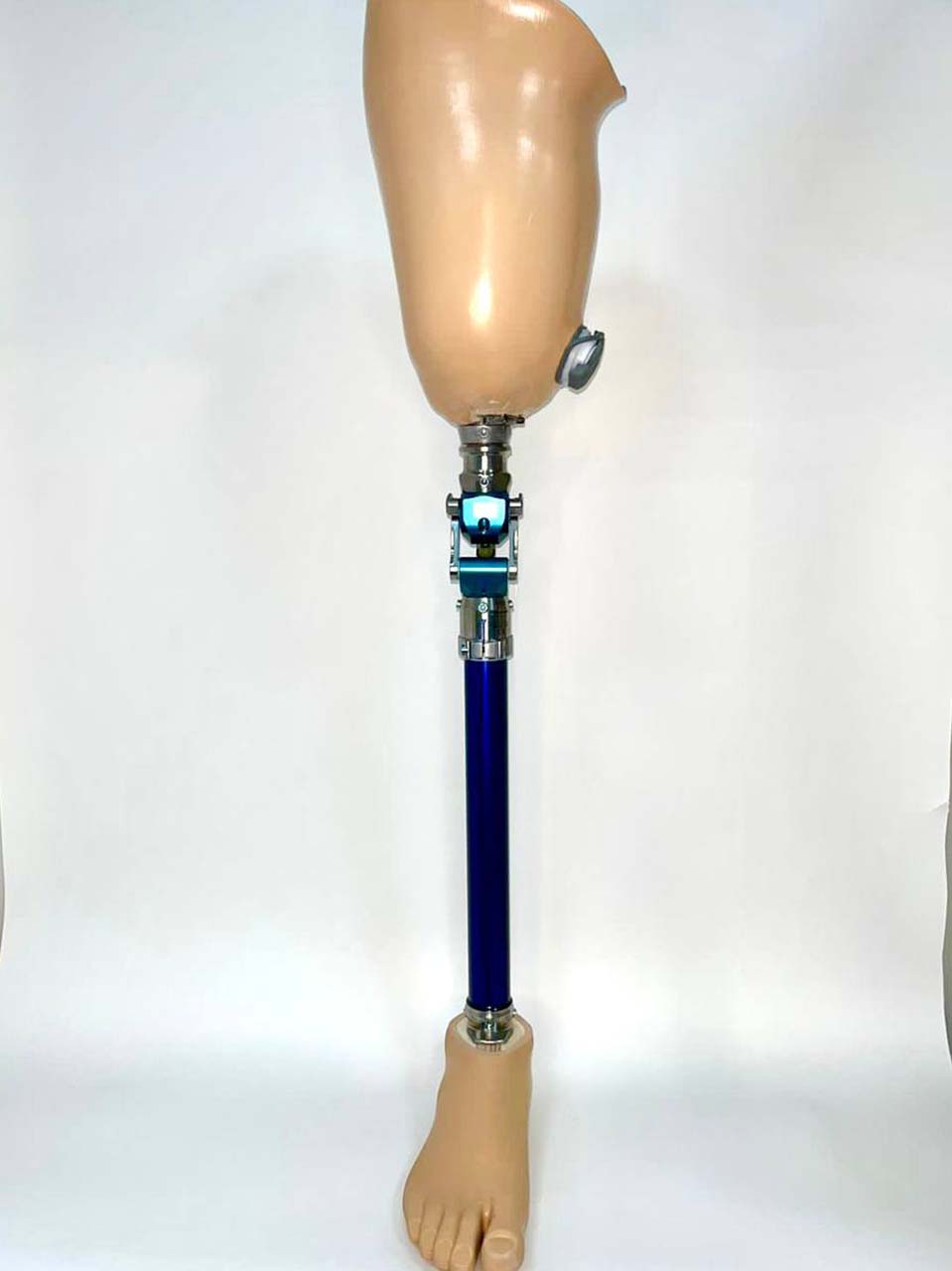
– 02
Non-modular prosthesis
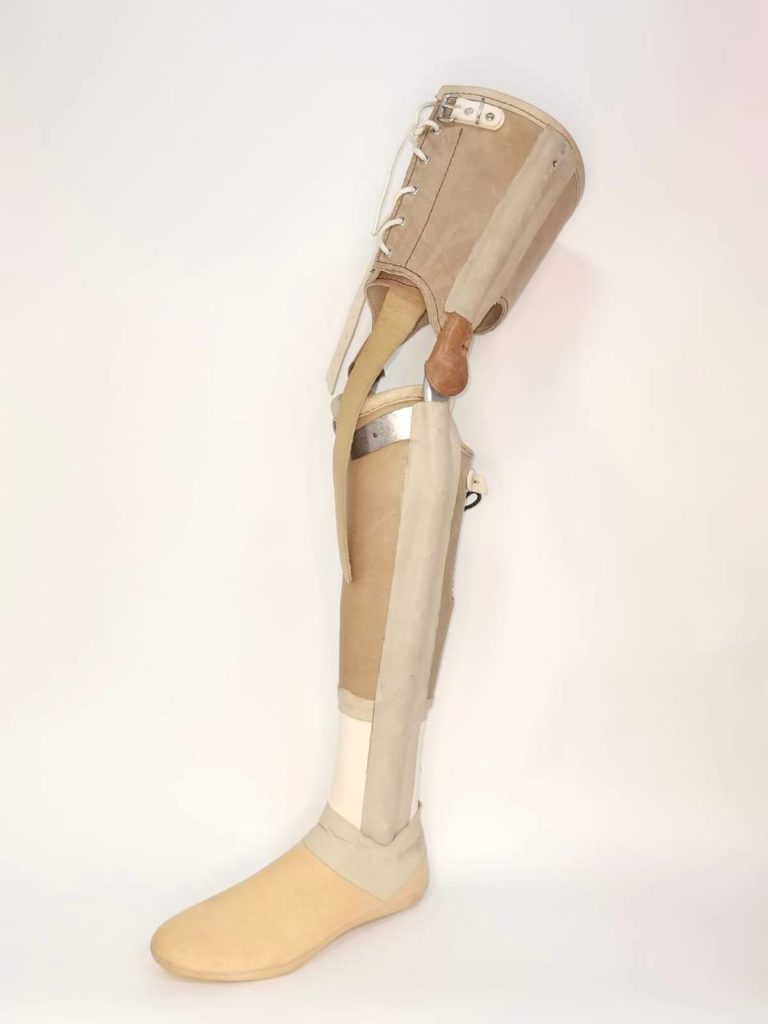
– 03
Floating prostheses (modular and non-modular)
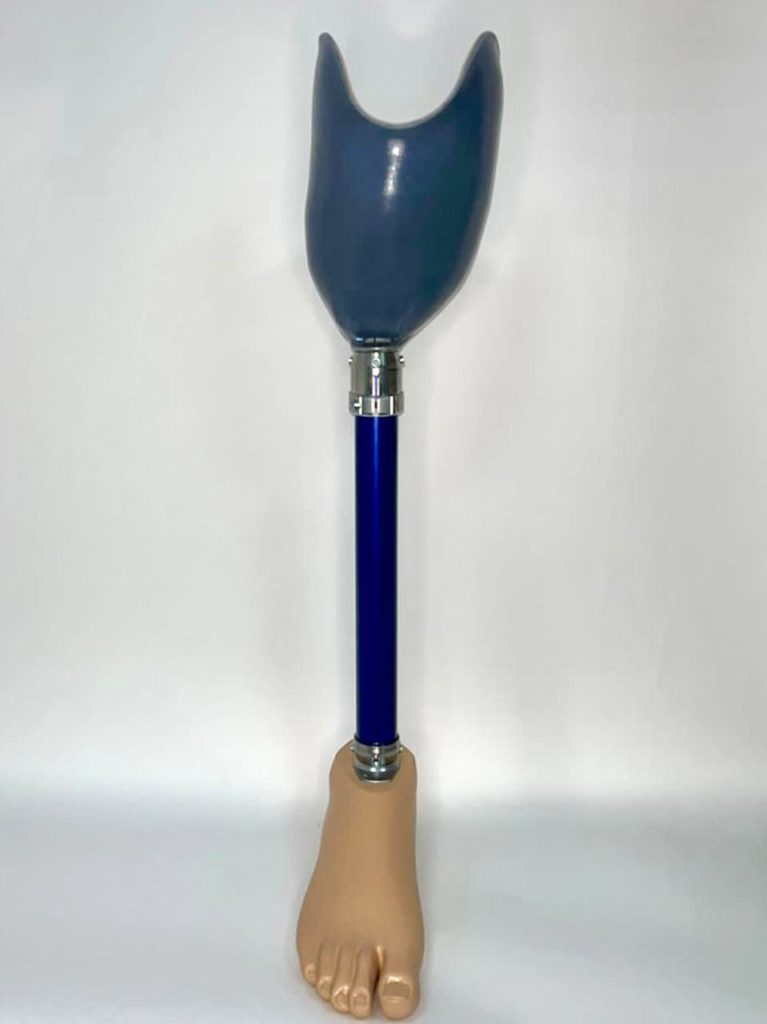
The prosthesis is an individual product, made on the basis of a medical-technical assessment and taking into account the patient's preferences. In accordance with the State Disability Act, we provide the patient with two prostheses with different functionality for walking and swimming.
The functionality of the prosthesis depends on the activity level of the patient.
The activity level is classified according to the Mobis system:
- Mobis 1 - is a very low level. The person moves slowly over short distances (mainly at home);
- Mobis 2 - low. Moves faster, but distances are limited. Capable of negotiating low obstacles such as curbs and bumps in the road;
- Mobis 3 - medium. Walks at medium to high speed. The person can comfortably overcome obstacles such as curbs, stairs, inclines and winding paths. ;
- Mobis 4 - high level of activity. Includes sports activities.
Modular prostheses
Their main technical feature is that they are made up of modules with different functions. With such a construction, one module can later be replaced by another, or additional adjustments can be made. The orthopedic technician fabricates the residual limb and orders the components (modules) separately from the manufacturer. A modular prosthesis consists of several basic modules and connection, adjustment and torsion elements:
- the residual limb, which is supplemented by a liner (silicone tube). Machined from a single butt casting;
- Adjusting and connecting elements (locks, valves, hinges, etc.);
- knee module. The model should be chosen according to the recommended activity level;
- basic module. It is equipped with adjustment devices;
- Foot. Feet with different functions are used.
- Mechanical (passive) - the functionality depends on the execution of the modules. Takes over the work of the missing joints;
- External drive (active) - the movements are controlled by microprocessors;
- Functional and cosmetic - the mechanism is hidden behind a cosmetic shell that simulates a healthy leg.
- The modules of the prosthesis can be exchanged;
- The prosthesis includes ankle adjustment, a switching mechanism for different gaits, torsion devices (damping, stabilization);
- Multiple control options: mechanical, pneumatic cylinders, hydraulic cylinders;
- Convenient and safe to use;
- The accessories from the leading manufacturers guarantee mobility and relieve the body.
The modular prosthesis technology is the most popular among both the users and the prosthetists. They are prescribed after complex operations with joint dislocations and in patients with congenital defects. The possibilities of prostheses are endless as long as the human himself does not set up boundaries of complexes and fears.
Where should a leg amputated patient start?
In the first place, he should strive to regain and restore the lost function. According to Russian law, after such an operation, a citizen is entitled to a disability group and social protection. Patients hospitalized for amputation receive prompt assessment and the necessary technical rehabilitation tools. Our medical center offers clients a full range of medical services, from providing an assessment of the need for prostheses and other assistive devices, to manufacturing a custom-made prosthetic leg and training in its use.
- Leg prosthesis for ankle replacement
- Below-knee prosthesis in below-knee amputation
- Hip prosthesis if the knee joint can no longer be saved.
All modern prostheses are manufactured as prefabricated components.
A hip prosthesis consists, for example, of a hip socket (stump socket), a knee module and a foot module. These parts are connected by adjustment devices made of durable metal alloys that replace the patient's lost bone. If desired, the prosthesis can be provided with a cosmetic coating that makes the product look like a healthy limb.
The hip socket is the basis for comfortably wearing the prosthetic leg. It should hold the residual limb firmly without rubbing or compressing the tissue. The acetabular cup is made strictly based on the impression. Our specialists pay special attention to this part of the operation, making as many adjustments as necessary to ensure maximum comfort for the patient. The residual limb itself can be anchored in the acetabulum in different ways, depending on the patient. The least traumatic and modern method is to use a silicone sleeve.
MOSCOW CENTER FOR PROSTHETICS AND ORTHOPEDICS
The Moscow Rehabilitation and Orthopedic Center has been engaged in lower limb prosthetics for ten years. The RTC produces a wide range of modern modular prostheses using high-tech modules from the Icelandic company Ossur and the German company Otto Bock. In addition, the specialists of the center use proven modules from the Russian company Metiz for the production of inexpensive prostheses. These manufacturers are constantly improving their technology, both in terms of functionality, durability and practicality of the artificial modules, as well as their design.
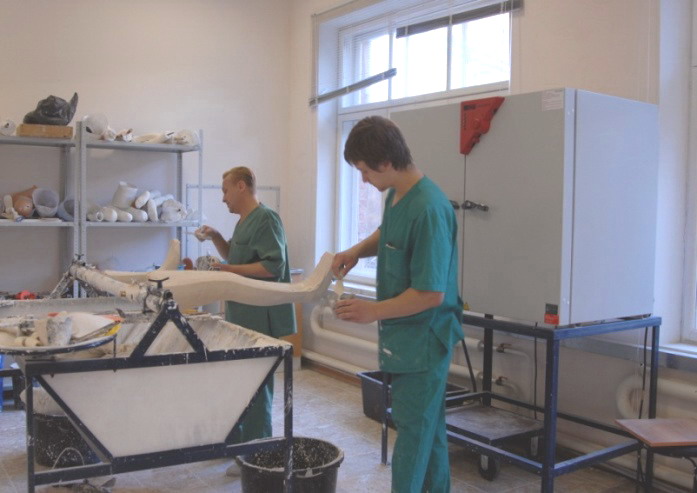
In an effort to maximize the quality of life of people who, for one reason or another, depend on prostheses and orthopedic devices, manufacturers improve the materials and expand the range of assemblies and building blocks year after year. The qualified prosthetists of our center are therefore able to produce a comfortable unit in a relatively short time, taking into account all the individual needs of the patient. This includes the type and degree of amputation, previous illnesses, residual limb condition, age, activity level, occupation, personal wishes and financial possibilities.
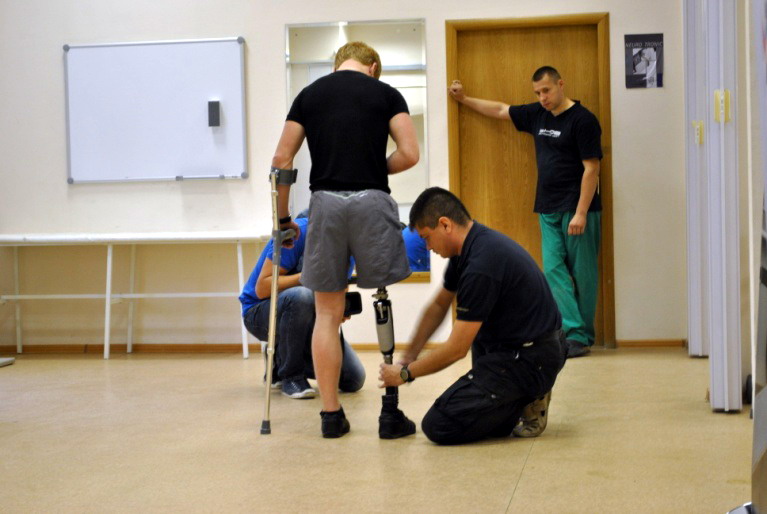
The variety of designs makes it possible to make the ideal prosthesis for everyday life, work or active sports. Each patient is cared for by a qualified and experienced prosthetist who accompanies them through all the phases of fitting the prosthesis: from impression taking to psychological preparation and complete rehabilitation.
ROC's specialists can create state-of-the-art bionic prostheses equipped with a microprocessor that learns as you use it, allowing you to walk as naturally as possible. The most advanced modules are used for these prostheses.
- prosthetic legs.
- blunt.
- Leg prosthesis below the knee.
- prosthetic leg.
- acetabulum.
- The reamputation is.
- Cult at Shopar.
- How much does a prosthetic foot cost?.
